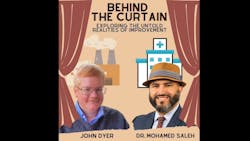Podcast: How the Age of Your Organization Shapes the Lean Journey
One manufacturing company is more than a century old. Another one, located down the block, is much younger, with fewer than 10 years of experience.
Is the approach to transformational change the same at both enterprises? Does the age of an organization matter?
In this episode of Behind the Curtain: Adventures in Continuous Improvement, cohosts Dr. Mohamed Saleh and John Dyer explore how age impacts organizational change.
They discuss:
- How deeply rooted habits can become entrenched at older organizations, making it difficult to create new norms. “The phrase ‘We've always done it that way’ comes from an age of an organization,” notes Saleh.
- Why young entrepreneurial organizations, having struggled and suffered to get the new business off the ground, may not “take too kindly to any kind of outside help or advice, because they've been doing the struggle themselves for so long,” Dyer says.
- The need to consider the tenure of the individuals within an organization in addition to the age of the enterprise.
- How an older organization is more likely than a younger one to have tried and failed at a lean effort, making it more resistant to new attempts.
- Why past success can hinder change at an older organization. In such instances, “Success has actually become a blinder, or a blind spot for them, for all the new deficiencies that are creeping in,” Saleh notes. The organization continues with what worked 40 years ago, “but times have changed. Context has changed. Customers have changed.”
Saleh and Dyer also delve into the dynamics of younger generations of workers joining older organizations, with Saleh commenting, “What I have found in older organizations is that the newer comes in with this passion and this new way of thinking that is sometimes perceived as not honoring the legacies.”
The takeaway from this session: Don’t take a cookie-cutter approach to organizational change. Consider age when developing your method.
